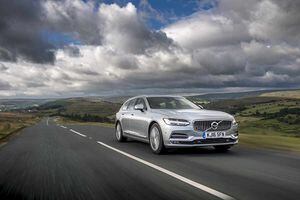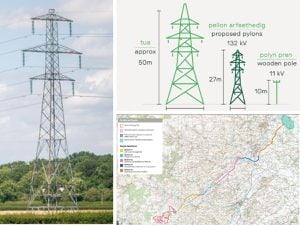Volvo luxury estate to reclaim top spot

The pinnacle (so far, anyway) is the new V90, a luxury estate with which it aims to win back dominance in a sector of the market which it enjoyed with the likes of V70.
Say 'estate' and you'd think Volvo. That's just how it was. But that car faced increasing competition from estate versions of the Audi A6, BMW 5 Series and Mercedes E-Class who all wanted Volvo's place in the manager's parking spot. That could be about to change as the Swedes launch the V90, the biggest, most technologically advanced and safety luxury estate so far.
Practicality is its purpose, but no-one could accuse the V90 of being boxy: it's long, low and wide, with a sleek and sculpted look which is verging on the sporty: no mean feat for such a large car.
It will hit Britain's roads alongside its sibling, the S90 premium saloon with which is shares a platform (that of the award-winning XC90 SUV) as well as mechanical, trim and equipment - everything apart from the cargo-carrying rear end and tailgate, in fact. There is a choice of two diesel engines - both four cylinder - with either 190PS in the D4 or 235PS in the D5. Both are fitted with eight-speed automatic smooth operation and acceleration, and a higher top for better economy.
The S90 saloon starts at £32,500 for the D4 in Momentum trim rising to £42,000 for the D5 all-wheel drive in flagship Inscription trim. The V90 estates cost £2,000 more, model for model. Both cars carry up to five adults in club class luxury, with finely stitched leather upholstery, real wood, chrome and high gloss services, with automatic climate control, an upmarket audio system and the latest smartphone connectivity systems controlled through a central touchscreen.
The wood, clean design and lack of superfluous buttons give the car a distinctively Scandinavian feel. Volvo has made a clear decision that, even in this flagship car, it will never use anything more than a four cylinder engine, relying instead on technology to compete on performance without using a bigger, thirstier power plant.
Not that the S/V90s are sluggish, or thirsty. Take the heaviest, most powerful V90 - the 235PS all wheel drive - which does the 0 to 62mph dash in just 7.2 seconds and is still capable of averaging an impressive 57.6mpg. The 190PS version of the saloon's figures are 8.2 seconds and 64.2mpg. CO2 emissions figures range from a low 116 to 129g/km - the latter remarkable for a big, premium car.
Mind you, the more powerful of the two engines, the D5, has a trick up its sleeve which makes it quicker off the mark than some six cylinder and even three-litre rivals. Simple but effective, the D5 has a new PowerPulse system which stores compressed air then - when you put down for a quick take-off - it uses this to scroll up the turbo and bring in maximum torque that much sooner.
A T8 plug-in hybrid model, with petrol and electric motors borrowed from the XC90 hybrid, will be available before too long. Its vital statistics are pretty staggering: 407bhp, 0 to 62mph in 5.2 seconds and a tax-busting CO2 rating of just 44g.km - low even by hybrid standards.
Another option available for S/V90 drivers is 'Pilot Assist', a development of adapative cruise control which uses radar to brake or accelerate, kpeeing your car a set distance from those in front. Volvo's system can also keep the car centered in a lane - provided there are white lines on either side as on a motorway or dual carriageway. Volvo stresses this is a driver support system, not autonomous driving: you still have to hold the steering wheel and it does work. Once I got used to it, it proved pretty relaxing.
It fits in with Volvo's philosophy for these flagship models: it says quite clearly that it is not trying to compete with the driving dynamics of its German rivals, but to provide a 'relaxed and confident' experience.
It does, too. You're always aware this is a Volvo, with its generations of experience in safety innovations starting with the passenger cell reinforced with the strongest steels available, plus airbags and a full array of electronic systems. On the practical side, the saloon's boot has a useful 500-litres of space, while the V90 has 60 more litres with the rear seats up - and almost 2,000-litres with them folded down. On both models, the rear seats and headrests can be folded electrically.
Both cars also benefit from the Sensus control system from the XC90, based on a central touch screen control which reduces the usual clutter of buttons and switches. It is full compatible with smartphone apps, offers internet connectivity and can be controlled by up to 300 voice commands, as well as touch screen or steering wheel buttons. Both car and saloon have electrically-operated boot lids, and even the basic models benefit from a new, space-saving suspension sysem.
Basically it has a transverse-mounted foil spring at the rear replacing the usual coil springs on the side, reducing intrusion into load space. A a second benefit is the reduced roll rates, which means the Volvo avoids any big car tendency to roll through corners. The standard car's ride is everything you'd expect of a luxury car, but it's even better if you opt for the multi-mode, optional air suspension system, a £1,600 option.
Volvo expects the V90 estate to be the biggest seller of the two new models adn I'm sure they will be proven right. It is particularly sleek and shapely for a such a big car that comes with class-leading safety and practicality, as well as two impressively punchy but economical engines.
The V90 is an estate of the art: it puts Volvo back at the head of the class when it comes to cars capable of carrying passengers or cargo in style.





